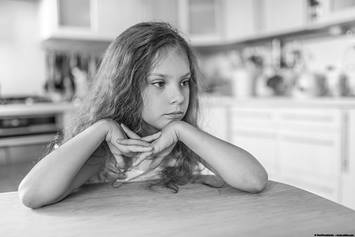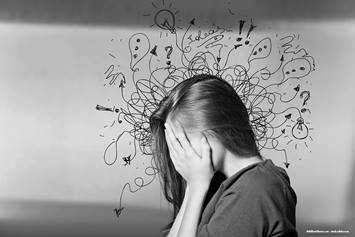Anxiety
Anxiety disorders are the most common type of mental health disorder in childhood.
What Are Anxiety Disorders in Children?
Stress is a normal part of life. And occasional anxiety is a normal reaction to stress.
A certain amount of anxiety can be useful. Even motivating. It can keep us alert and focused. It can help us do our best.
Anxiety becomes a problem when it becomes overwhelming. When it will not go away. When it prevents you from doing things and gets worse over time.
That’s when anxiety becomes an illness. There are several types of anxiety disorders, and they affect children and adolescents as well as adults.
In fact, anxiety disorders are the most common type of mental health disorder in childhood.
What Are Anxiety Disorders?
Anxiety disorders affect one out of every eight children. Untreated, young people with anxiety disorders are at a higher risk to struggle in school and in their relationships with adults and peers.
They are more likely to underachieve and miss out on important social experiences. And more likely to engage in substance abuse.
There are many types of anxiety disorders. Each has its own distinct symptoms.
Children with anxiety disorders share a prolonged sense of intense distress. It’s a combination of worry and dread that can impact all aspects of a child’s daily life.
The major types of anxiety disorders include:
- Generalized anxiety disorder, where a child worries too much about too many things. In children, this anxiety often focuses on performance in school or sports. It may drive extreme studying or practicing, striving for perfection. Children with this disorder can be very hard on themselves. They may seek constant approval or reassurance from others.
- Panic disorder, where a child suffers from unexpected panic or anxiety attacks. These attacks come on suddenly and for no apparent reason. Children with panic disorder find little relief between attacks. In-between, they are haunted by concerns over having another attack. They fear losing control, or “going crazy.”
- Separation anxiety disorder, where a child as old as nine cannot bear to be separated from a parent or other family member. Separation anxiety is normal for children age three and under. Older children who cannot bear separation may refuse to go to school, camp, or a sleepover. They might demand that someone stay with them at bedtime.
- Social anxiety disorder, where a child has an intense fear of social and performance situations. It’s a persistent “stage fright” that can significantly impair school performance and attendance. It can also hinder a child’s ability to socialize and develop friendships among peers.
- Selective Mutism, where a child refuses to speak in situations where talking is expected. Or even required. They may be talkative at home or any place where they feel comfortable. And then stand motionless and silent in school, chewing or twirling their hair, avoiding eye contact. At the first opportunity, they prefer to withdraw to a corner where they can avoid talking.
- Specific phobias, where a child is gripped by an intense, irrational fear of a specific object or situation. Common childhood phobias include animals, storms, heights, water, blood, the dark and medical procedures.
- Obsessive-compulsive disorder (OCD), where a child’s behavior is ruled by unwanted and intrusive thoughts (obsessions). The child also feels compelled to perform rituals (compulsions) to try and ease his or her anxiety. Boys are more likely to develop OCD before puberty. Among girls, the disorder tends to emerge during adolescence.
- Posttraumatic Stress Disorder (PTSD), where a child feels intense fear or anxiety after experiencing or witnessing a traumatic or life-threatening event. Many children will recover naturally in a short time. Children with PTSD do not. The fear lingers and intensifies. And they become emotionally numb or easily agitated.
What Are the Symptoms of Anxiety?
Regardless of the disorder, anxiety results in fear or preoccupation that interferes with a child’s happiness and ability to do basic things. The anxiety can be puzzling both to the child and to parents.
While each disorder has its own symptoms, there are some signs of anxiety that are characteristic of most of the disorders. These include:
- Recurring fears about routine parts of life.
- Excessive worry most days of the week, for weeks on end.
- Physical complaints, like stomach aches or headaches.
- Trouble concentrating.
- Trouble sleeping at night.
- Restlessness or fatigue during waking hours.
- Fear of social situations.
- Fear of leaving home.
- Fear of separation from a loved one.
- Frequent irritability.
Children with anxiety disorders are reluctant to talk about their feelings. They worry that parents and others won’t understand. Boys are especially reluctant to risk being judged as weak, scared or “babyish.” That’s why they keep their feelings and fears to themselves. And end up feeling alone or misunderstood.
How Is Anxiety Diagnosed?
The first step to successful treatment begins with a diagnostic assessment. These assessments normally include:
- A review of current symptoms
- A thorough review of the child's development and background
- Past medical and psychiatric history
- Establishing a picture of the family background
- A mental status exam
Parents and guardians are included in the evaluation process. They are often encouraged to participate in treatment planning.
How Is Anxiety Treated?
There is no one, set formula. Treatment is as unique as the child being treated.
Treatment may include:
- Cognitive behavioral therapy for the child
- Medication
- Family therapy
- Parent education and support
- Working with the school system to reduce impact of anxiety on academics
Parents and guardians play an essential role in their child's treatment. Family support is critical, too.
When Should You Seek Help For Your Child’s Anxiety?
Today doctors and therapists understand better than ever how anxiety impacts children. They also have proven treatment options to help young people manage and overcome their anxiety.
Talk with your child. And most importantly, listen. If you suspect at all that your child needs help, let a mental health professional assess your child’s situation.



